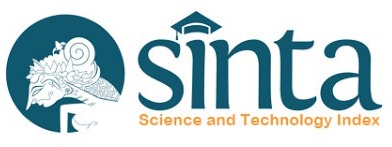Karakteristik Fisikokimia, Sensoris, Dan Mikrobiologis “Crisweed” Snack Olahan Rumput Laut Eucheuma cottonii
Abstract
“Crisweed” merupakan snack olahan rumput laut non MSG dengan komposisi kentang, rumput laut, dan nori dimana kombinasi bahan bahan tersebut diharapkan mampu meningkatkan nilai nutrisinya terutama kandungan serat dan vitamin yang bersumber dari rumput laut. Penelitian ini bertujuan mengetahui formulasi terbaik pada rasio penambahan rumput laut pada snack dengan memfokuskan pada mutu tekstur dan kerenyahan produk. Parameter uji untuk seaweed snack dilakukan melalui uji hedonik terhadap rasa, aroma, tekstur dan kenampakan serta analisis kimia yang meliputi kadar air, abu, lemak, protein dan serat kasar. Uji parameter tekstur meliputi hardness, adhesiveness, cohesiveness, dan elasticity. Hasil uji hedonik menunjukkan adanya perbedaan yang signifikan pada atribut rasa, aroma, tekstur dan kenampakan. Nilai kadar air produk berada pada kisaran 3,67-7,49%, protein 7,54-12,23%, lemak 15,60-18,82%, abu 1,74-5,26% dan serat 15,78-16,71%. Berdasarkan uji pembobotan De Garmo terhadap semua parameter uji, ditemukan produk “Crisweed” perlakuan terbaik adalah pada formulasi 3 dengan nilai efektivitas 0,88.
ABSTRACT
“Crisweed” is a non-MSG seaweed snack with a composition of potatoes, seaweed, and nori where the combination of these ingredients is expected to increase its nutritional value, especially the fiber and vitamin content sourced from seaweed. This study aims to determine the best formulation of the ratio of seaweed addition to snacks by focusing on the quality of texture and crispiness of the product. Test parameters for seaweed snacks were carried out through hedonic tests on taste, aroma, texture and appearance as well as chemical analysis including water content, ash, fat, protein and crude fiber. As well as texture parameter tests including hardness, adhesiveness, cohesiveness, and elasticity. The results of the hedonic test showed significant differences in the attributes of taste, aroma, texture and appearance. The water content of the product was in the range of 3.67-7.49%, protein 7.54-12.23%, fat 15.60-18.82%, ash 1.74-5.26% and fiber 15.78-16.71%. Based on the De Garmo test on all test parameters, it was found that the best treatment for the “Crisweed” product was formulation 3 with an effectiveness value of 0.88.
Keywords
Full Text:
PDF (Bahasa Indonesia)References
Anggraini, P. (2018). Pemanfaatan Rumput Laut (Eucheuma cottonii) Menjadi Roti Tinggi Serat dan Yodium. ARGIPA (Arsip Gizi Dan Pangan), 3(1), 26–36. https://doi.org/10.22236/argipa.v3i1.2921
Arámbula-Villa, G., González-Hernández, J., & Ordorica-Falomir, C. A. (2001). Physicochemical, structural and textural properties of tortillas from extruded instant corn flour supplemented with various types of corn lipids. Journal of Cereal Science, 33(3), 245–252. https://doi.org/10.1006/jcrs.2001.0372
Argüello-García, E., Martínez-Herrera, J., Córdova-Téllez, L., Sánchez-Sánchez, O., & Corona-Torres, T. (2017). Propiedades de textura, química y sensorial de tortillas de maíz fortificadas con harina de jatropha curcas L. no tóxica. CYTA - Journal of Food, 15(2), 301–306. https://doi.org/10.1080/19476337.2016.1255915
BSN. (2006). SNI Organoleptik.
BSN. (2015). SNI 2886:2015 Makanan Ringan Ekstrudat. Bsn, 1–41. file:///C:/Users/User/Downloads/SNI_2886_2015_Makanan_ringan_ekstrudat.pdf
Cahyono, E., Rieuwpassa, F. J., & Sirih, S. (2018). Analisis organoleptik tortilla rumput laut kappaphycus alvarezii. Jurnal Ilmiah Tindalung, 4(2), 61–65.
De Garmo, E.D., Sullivan, W.G., dan J.R Canada.(1984). Engineering Economy. Milan Publishing Company. New York
Daud, R. (2013). Pengaruh masa tanam terhadap kualitas rumput laut, Kappaphycus alvarezii. Media Akuakultur, 8(2), 135. https://doi.org/10.15578/ma.8.2.2013.135-138
Gunawan, A., Rizianiza, I., & Adnyani, L. P. (2019). Peningkatan Produktivitas Poklahsar Swakarya Bersama Melalui Produksi Tortilla Olahan Rumput. Jurnal Abdimas BSI: Jurnal Pengabdian Kepada Masyarakat, 2(2), 241–250. https://doi.org/10.31294/jabdimas.v2i2.5802
Handayani, R., & Aminah, S. (2011). Variasi Substitusi Rumput Laut terhadap Kadar Serat dan Mutu Organoleptik Cake Rumput Laut (Eucheuma cottonii) Dietary Fiber and Organoleptic value on Cake Seaweed (Eucheuma cottonii) from the Seaweed Substitution. Jurnal Pangan Dan Gizi, 02(03), 67–74.
Harden, C. J., Craig Richardson, J., Dettmar, P. W., Corfe, B. M., & Paxman, J. R. (2012). An ionic-gelling alginate drink attenuates postprandial glycaemia in males. Journal of Functional Foods, 4(1), 122–128. https://doi.org/10.1016/j.jff.2011.09.002
Hermawan, D., Harini, N., Jasmine, C., & Pakpahan, O. P. (2018). Functional of Seaweed Dodol. 14(2), 37–42.
Kurniawan, A. B., Al-Baarri, A. N., & Kusrahayu. (2012). Kadar serat kasar, daya ikat air, dan rendemen bakso ayam dengan penambahan karagenan. Jurnal Aplikasi Teknologi Pangan, 1(2), 23–27.
Kustantinah, Hidayah, N., Noviandi, C. T., Astuti, A., & Paradhipta, D. H. V. (2022). Nutrients content of four tropical seaweed species from Kelapa Beach, Tuban, Indonesia and their potential as ruminant feed. Biodiversitas, 23(12), 6191–6197. https://doi.org/10.13057/biodiv/d231213
Matanjun, P., Mohamed, S., Mustapha, N. M., & Muhammad, K. (2009). Nutrient content of tropical edible seaweeds, Eucheuma cottonii, Caulerpa lentillifera and Sargassum polycystum. Journal of Applied Phycology, 21(1), 75–80. https://doi.org/10.1007/s10811-008-9326-4
Muchtadi, TR, Sugiyono, & Ayustaningwarno, F. (2010). Teknologi Proses Pengolahan Pangan. Bandung: Alfabeta
Nadia, N., Hafizah, E., & Istyadji, M. (2023). The effect of seaweed (Eucheuma Cottonii) substitution on the characteristics of Tilapia (Oreochromis niloticus) Nuggets. International Journal on Advanced Technology, Engineering, and Information System (IJATEIS), 2(1), 18–30. https://doi.org/10.55047/ijateis.v2i1.599
Niken, A., & Adepristian, D. (2013). Isolasi Amilosa dan Amilopektin dari Pati Kentang. Teknologi Kimia Dan Industri, 2(3), 57–62.
Pamungkas, A., Sedayu, B. B., Hakim, A. R., Wullandari, P., Fauzi, A., & Novianto, T. D. (2023). Perkembangan penelitian aplikasi rumput laut sebagai bahan pangan di Indonesia: tinjauan literatur. Agrointek : Jurnal Teknologi Industri Pertanian, 17(3), 557–570. https://doi.org/10.21107/agrointek.v17i3.16484
Panjaitan, P. S., Panjaitan, T. F., Siregar, A. N., & Sipahutar, Y. H. (2020). Karakteristik mutu tortila dengan penambahan rumput laut (Eucheuma cottonii). Aurelia Journal, 2(1), 73. https://doi.org/10.15578/aj.v2i1.9406
Prawiro, M. (2020). Gizi tortilla chips dan kontribusinya.
Purwaningsih, S., & Deskawati, E. (2021). Karakteristik dan Aktivitas Antioksidan Rumput Laut Gracilaria sp. Asal Banten. Jurnal Pengolahan Hasil Perikanan Indonesia, 23(3), 503–512. https://doi.org/10.17844/jphpi.v23i3.32808
Puspaningrum, L., Yuwono, S. S., & Martati, E. (2018). Karakteristik Fisikokimia dan Sensoris Fruit Leather Apel Manalagi (Malus sylvestris Mill) dengan Subtitusi Pisang Candi (Musa Paradisiaca) Physicochemical Characteristics and Sensory of Fruit Leather Apple Manalagi (Malus sylvestris mill) With The Substi. Jurnal Teknologi Pertanian, 19(3), 173–182.
Rizkaprilisa, W., Griselda, A., Hapsari, M. W., Program, R. P., Pangan, T., Sains, F., Teknologi, D., Karangturi, N., Patah, J. R., & Artikel, S. (2023). 3 (2) Science, Technology and Management Journal pemanfaatan rumput laut sebagai pangan fungsional: systematic review Info Artikel. Science, Technology and Management Journal, 3(182), 28–33. http://journal.unkartur.ac.id/index.php/stmj
Rosida, D. F., Putri, N. A., & Oktafiani, M. (2020). Karakteristik cookies tepung kimpul termodifikasi (Xanthosoma sagittifolium) dengan penambahan tapioka. Agrointek, 14(1), 45–56. https://doi.org/10.21107/agrointek.v14i1.6309
Rubio, C., Napoleone, G., Luis-González, G., Gutiérrez, A. J., González-Weller, D., Hardisson, A., & Revert, C. (2017). Metals in edible seaweed. Chemosphere, 173, 572–579. https://doi.org/10.1016/j.chemosphere.2017.01.064
Sa'adah, D.A. (2017). Pembuatan Produk Tortilla Chips Rumput Laut (Eucheuma cottonii) dan Ikan Kembung (Rastrelliger sp.).
Salinas-Moreno, Y., Belem Castillo-Linares, E., Gricelda Vázquez-Carrillo, M., & Ofelia Buendía-González, M. (2011). Mezclas de maíz normal con maíz ceroso y su efecto en la calidad de la tortilla. Revista Mexicana de Ciencias Agrícolas, 2, 689–702. https://www.scielo.org.mx/scielo.php?script=sci_arttext&pid=S2007-09342011000500005
Salosso, Y., Aisiah, S., Toruan, L. N. L., & Pasaribu, W. (2020). Nutrient content, active compound, and antibacterial activity of Padina australis against aeromonas hydropilla. Pharmacognosy Journal, 12(4), 771–776. https://doi.org/10.5530/pj.2020.12.110
Sandrasari, D. A., & Chusna, A. C. (2020). Karakteristik Crispy Cookies Kaya Serat Berbahan Dasar Rumput Laut. Jurnal Teknologi Pangan Dan Kesehatan (The Journal of Food Technology and Health), 2(2), 105–114. https://doi.org/10.36441/jtepakes.v2i2.525
Siahaan, E. A., Pangestuti, R., & Kim, S. K. (2018). Seaweeds: Valuable Ingredients for the Pharmaceutical Industries. In Grand Challenges in Biology and Biotechnology. https://doi.org/10.1007/978-3-319-69075-9_2
Sihite, N. W., Eliza, E., & Zebua, E. A. (2023). Daya Terima Fortifikasi Tepung Eucheuma Cottonii pada Produk Dimsum sebagai Alternatif Pangan Kaya Serat. Jurnal Sehat Mandiri, 18(1), 42–52. https://doi.org/10.33761/jsm.v18i1.766
Sihite, N. W., & Rotua, M. (2022). Analisa kandungan proksimat dan serat siomay rumput laut (Eucheuma cottonii) sebagai camilan sehat untuk remaja obesitas. Jurnal Kesehatan Manarang, 8, 179–187.
SNI-01-2354.2. (2015). Pengujian Kadar Air pada Produk Perikanan. 8. http://sispk.bsn.go.id/SNI/Detail SNI/10154
SNI. (2006). Petunjuk Pengujian Organoleptik dan atau Sensori 01-2346-2006. BSN (Badan Standarisasi Nasional), 2–14.
Sumartini, Gurusmatika, S., & Amira, W. (2021). The effect of food additive on physicochemical characteristics of seaweed stick snack and consumer acceptance. Canrea Journal: Food Technology, Nutritions, and Culinary Journal, 4(2), 102–113. https://doi.org/10.20956/canrea.v4i2.424
Syafitri, T., Hafiludin, H., & Chandra, A. B. (2022). Pemanfaatan Ekstrak Rumput Laut (Eucheuma cottonii) Dari Perairan Sumenep Sebagai Antioksidan. Jurnal Kelautan: Indonesian Journal of Marine Science and Technology, 15(2), 160–168. https://doi.org/10.21107/jk.v15i2.14905
Valentine, G., Sumardianto, & Wijayanti, I. (2020). Characteristic of Nori from Combination of Ulva lactuca and Gelidium Seaweed. Jurnal Pengolahan Hasil Perikanan Indonesia, 23(2), 295–302. https://doi.org/10.17844/jphpi.v23i2.32340
Veronika, H. H., Mappiratu, & Sumarni, N. K. (2017). Extraction and characterization of seaweed pigment extract (Eucheuma cottonii). KOVALEN Jurnal Riset Kimia, 3(1), 7–16. https://media.neliti.com/media/publications/144532-ID-ekstraksi-dan-karakterisasi-ekstrak-zat
Widati, A. S., Rosyidi, D., Radiati, L. E., & Nursyam, H. (2021). The Effect of Seaweed (Eucheuma cottonii) Flour Addition on Physicochemical and Sensory Characteristics of an Indonesian-Style Beef Meatball. International Journal of Food Studies, 10(February), SI111–SI120. https://doi.org/10.7455/ijfs/10.SI.2021.a9
Winarno, H. (2015). Ti-017. Analisis Tata Letak Fasilitas Ruang Fakultas Teknik Universitas Serang Raya Dengan Menggunakan Metode Activity Relationshipchart (Arc), November, 2. jurnal.ftumj.ac.id/index.php/semnastek
Yakhin, L.A., Wijaya, K.M., & Santoso, J. (2013). The Effect of Seaweed powder (Eucheuma cottonii) addition in Catfish sausage. The 1st International Symposium on Aquatic Product Processing, 19(8), 421–425.
DOI: https://doi.org/10.15578/jpbkp.v19i2.1113
Refbacks
- There are currently no refbacks.
JPBKP adalah Jurnal Ilmiah yang terindeks :
ISSN : 1907-9133(print), ISSN : 2406-9264(online)
This work is licensed under a Creative Commons Attribution-NonCommercial-ShareAlike 4.0 International License.








